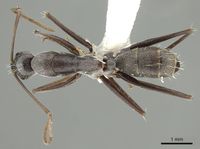Camponotus stefani
| Camponotus stefani | |
|---|---|

| |
| Scientific classification | |
| Kingdom: | Animalia |
| Phylum: | Arthropoda |
| Class: | Insecta |
| Order: | Hymenoptera |
| Family: | Formicidae |
| Subfamily: | Formicinae |
| Tribe: | Camponotini |
| Genus: | Camponotus |
| Species: | C. stefani |
| Binomial name | |
| Camponotus stefani McArthur, 2007 | |
Nest is in soil with high clay content, entrance to nest is a small circular hole scarcely larger than major worker's head. Common in Adelaide parklands. Frequently seen foraging on trees in day time. (Mcarthur 2007)
Identification
McArthur (2007) - The presumed nearest relative Camponotus extensus has short setae on its scape raised to about 45°.
Keys including this Species
Distribution
Latitudinal Distribution Pattern
Latitudinal Range: -26.53333333° to -36.61666667°.
| North Temperate |
North Subtropical |
Tropical | South Subtropical |
South Temperate |
- Source: AntMaps
Distribution based on Regional Taxon Lists
Australasian Region: Australia (type locality).
Distribution based on AntMaps
Distribution based on AntWeb specimens
Check data from AntWeb
Countries Occupied
| Number of countries occupied by this species based on AntWiki Regional Taxon Lists. In general, fewer countries occupied indicates a narrower range, while more countries indicates a more widespread species. |

|
Estimated Abundance
| Relative abundance based on number of AntMaps records per species (this species within the purple bar). Fewer records (to the left) indicates a less abundant/encountered species while more records (to the right) indicates more abundant/encountered species. |

|
Biology
Castes
Nomenclature
The following information is derived from Barry Bolton's Online Catalogue of the Ants of the World.
- stefani. Camponotus stefani McArthur, 2007b: 104, figs. (w.) AUSTRALIA (South Australia, Australian Capital Territory, New South Wales, Victoria).
- Status as species: McArthur, 2010: 84; McArthur, 2014: 76.
Unless otherwise noted the text for the remainder of this section is reported from the publication that includes the original description.
Description
Worker
Major Mesosoma: in lateral view with a few scattered erect setae; pronotum weakly convex, mesonotum weakly convex but higher anteriorly; metanotum wide, distinct; propodeal dorsum with a slight convexity anteriorly followed by a weak depression; angle about 170°, well rounded; ratio dorsum/declivity about 1; node on the petiole with anterior face straight, summit blunt, posterior face mostly straight. Head: sides straight, tapering to the front, vertex weakly convex; frontal carinae narrow; frontal area distinct anteriorly; clypeus anterior margin narrow, projecting, widely concave between two teeth; clypeus with sparse flat-lying short white setae, integument reticulate punctate; about 6 teeth on mandibles; median clypeal carina absent; in lateral view, clypeus anterior two thirds flat and separated from convex posterior by an angle; erect setae under head < 5. Appendages: flat-lying indistinct setae on outside of tibiae, about 7 bristles inside in a row; setae on scape flat-lying, indistinct. Colour varies from black to red, legs slightly lighter.
Minor Mesosoma: in lateral view covered with plentiful white short flat-lying setae with a few scattered erect setae; pronotum weakly convex; mesonotum weakly convex, higher anteriorly; metanotum indistinct; propodeal dorsum with a slight convexity anteriorly; angle about 170°, well rounded; ratio dorsum/declivity about 4; node on the petiole elongate, with anterior face straight, summit straight, inclined upward, posterior face mostly straight. Head: sides straight, parallel; vertex weakly convex; frontal carinae narrow; frontal area distinct anteriorly; clypeus anterior margin projecting, convex, crenulate; clypeus with plentiful flat-lying short white setae, reticulate; 8 visible teeth on mandibles; median clypeal carina distinct; erect setae under head < 5. Appendages: flat-lying indistinct setae on outside of tibiae, about 7 bristles inside in a row; setae on scape, flat-lying indistinct. Colour varies from black to red (from the same nest), legs slightly lighter.
The species is presumed dimorphic due to the absence of medium workers in the SAMA collection.
Type Material
- Holotype, minor worker, Jamestown, 33°12'S 138°36'E, South Australia, Australia, 33°12′0″S 138°36′0″E / 33.2°S 138.6°E, South Australian Museum.
- Paratype, 2 minor workers, Jamestown, 33°12'S 138°36'E, South Australia, Australia, 33°12′0″S 138°36′0″E / 33.2°S 138.6°E, Lowery,B.B., ANIC32-053475, Australian National Insect Collection.
- Paratype, 2 minor workers, Jamestown, 33°12'S 138°36'E, South Australia, Australia, 33°12′0″S 138°36′0″E / 33.2°S 138.6°E, Naturhistorisches Museum Wien, Vienna.
- Paratype, 2 minor workers, Jamestown, 33°12'S 138°36'E, South Australia, Australia, 33°12′0″S 138°36′0″E / 33.2°S 138.6°E, South Australian Museum.
Etymology
Named after the late Stefan Schödl in recognition of his contribution to myrmecology.
References
References based on Global Ant Biodiversity Informatics
- McArthur A. J. 2007. New species of Camponotus (Insecta: Hymenoptera: Formicidae) from Australia. Annalen des Naturhistorischen Museums in Wien. B, Botanik, Zoologie 108: 103-113.

